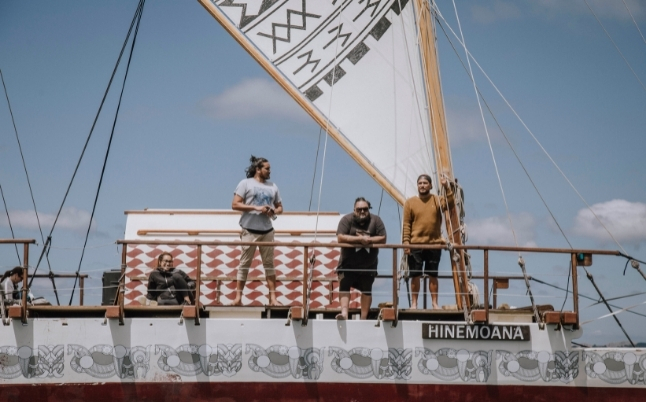Reti Hedley from indigenous soul group IA have released their waiata 'Kōkōrangi.' The waiata is accompanied by a music video that celebrates Pacific Voyaging. Reti and IA bring the unique sound of Taonga Puoro to their music. Nina Lesperance from SOUNZ caught up with Reti to talk about the new project and waiata.

Ko Tongariro te maunga
Ko Taupo te moana
Ko te Heuheu te tangata
Ko Waihi te marae
Ko Tāpeka te whare tupuna
Ko Ngati Turumakina te hapu
Ko Reti ahau
Kia ora, my name is Reti Hedley and I am a composer, musician, producer and taonga pūoro practitioner. I was raised with the knowledge of taonga pūoro through my late mother Rangiiria Hedley, who was a practitioner and educator of taonga pūoro. With my collaborators Moetu Smith and Turoa Pohatu we created IA, a music project where we create indigenous soul music featuring the voices of taonga pūoro.

Congratulations on the release of ‘Kōkōrangi.’ This beautiful waiata is played on a mixture of taonga pūoro and modern instruments. Can you tell us about the process in which you undertook to write this waiata?
Taonga pūoro have different scales that don’t perfectly align with western music theory, so bringing the two worlds together can be a challenge. It has been a lot of experimenting and trial and error to develop our music. Moetu and I spent a lot of time jamming and experimenting with taonga pūoro in the summer of 2019/2020.

Fast forward a few months and I was listening to some of our pūoro jams one morning and one of the demos stood out to me. This particular jam featured the voices of the traditional Kōauau (bone flute) and Ponga Ihu (nose flute). I played it back to the boys (Turoa and Moetu) and we decided it should be developed into our next waiata, which became Kōkōrangi.
We knew we wanted to write a song about how our ancestors navigated through the Pacific, so this concept inspired our lyrics. We wrote the waiata in te reo Māori first and then translated one of the verses into English. The vocal melody was inspired by the kōauau melody that we had jammed in the original Kōkōrangi demo.
The music video for ‘Kōkōrangi’ is a beautiful visual and is the first of its kind. How did the idea come about to make the trip on the waka to record the waiata?
We came up with the lyrics and song concept first. Part of what we are trying to achieve with IA is to capture live digital content that can engage all the senses, so that people can enjoy a multi sensory live taonga pūoro experience.
With this in mind, we thought hmmm…..how can we connect the lyrical content with the visuals? We thought, maybe we could perform on the shoreline with the waka’s in the background? Then the concept grew into... let's perform ON the waka!
We could think of many reasons why not to, like, weather risks, sound issues, logistics etc. But our drive to achieve the vision outweighed these barriers.
https://www.youtube.com/watch?v=XL2jfI2zbgA&t=3s
Was being on the waka a special experience for you all?
It’s always special being on a waka hourua. It's a chance to feel connected to our Pacific ancestors, the ocean voyagers and navigators. For Moetu and some of our film and photography crew, it was their first time, so I think it was extra special for them.
How did you find the filming process? Was it difficult to record and sail at the same time?
Yup! It took more than a few takes to get the final shot. Filming day started at 5.30am. We set sail at sunrise across Auckland Harbour to reach a quiet cove, which we thought would be a perfect location for filming/performing. Although it was sheltered, the wind gusts were still too much for the sensitive wind pūoro. I could barely play them because the wind would blow into them while I was trying to blow out.
So, our kaihautū/captain suggested we set sail and travel with the wind. If you are sailing in the same direction and at the same speed of the wind, you feel no wind....it worked….MAGIC! We still had a bit of wind in the mic, but nothing that my trusty, high tech sock couldn't fix!
We had also planned ahead and made sure that the live bass mix went directly into the interface and Turoa played on an electric drum kit. Big shout out to our captain and crew who carried us on the day and went above and beyond to help us make the vision a reality.

By filming the video on the waka, you are celebrating traditional Pacific Voyaging, what do you hope audiences take or learn from this video/ experience?
I hope that viewers feel like they are on the journey with us, gaining a sense of what it would have been like to sail alongside kaihautū such as Hoturoa, Toi, Turi and Kupe to name a few.
We also aim to bring our taonga pūoro to the forefront of our compositions. We hope to inspire others, particularly rangatahi, to continue the exploration of taonga pūoro.
Do you think IA will film more music videos using a similar format to promote and celebrate the art of Pacific voyaging?
IA have a few waiata lined up. None that are specifically related to Pacific voyaging. However, we aim to promote our pūoro, language and culture through all our waiata. One specific waiata which we have in the pipeline for later this year is titled ‘Whetu’. Whetu pays homage to taonga pūoro players who have paved the way in the revitalisation of the art but have since passed.
